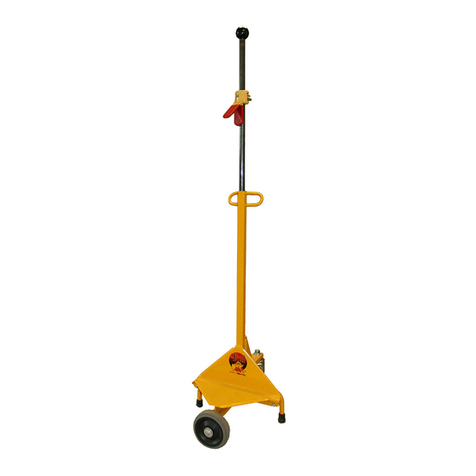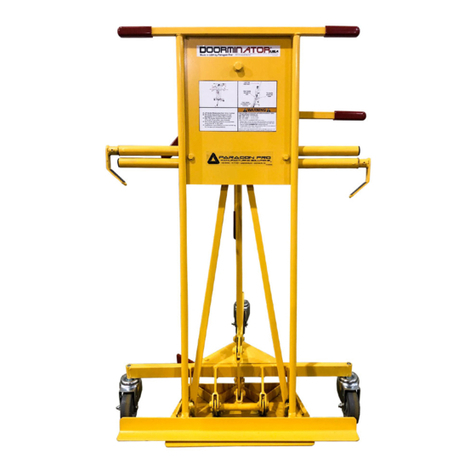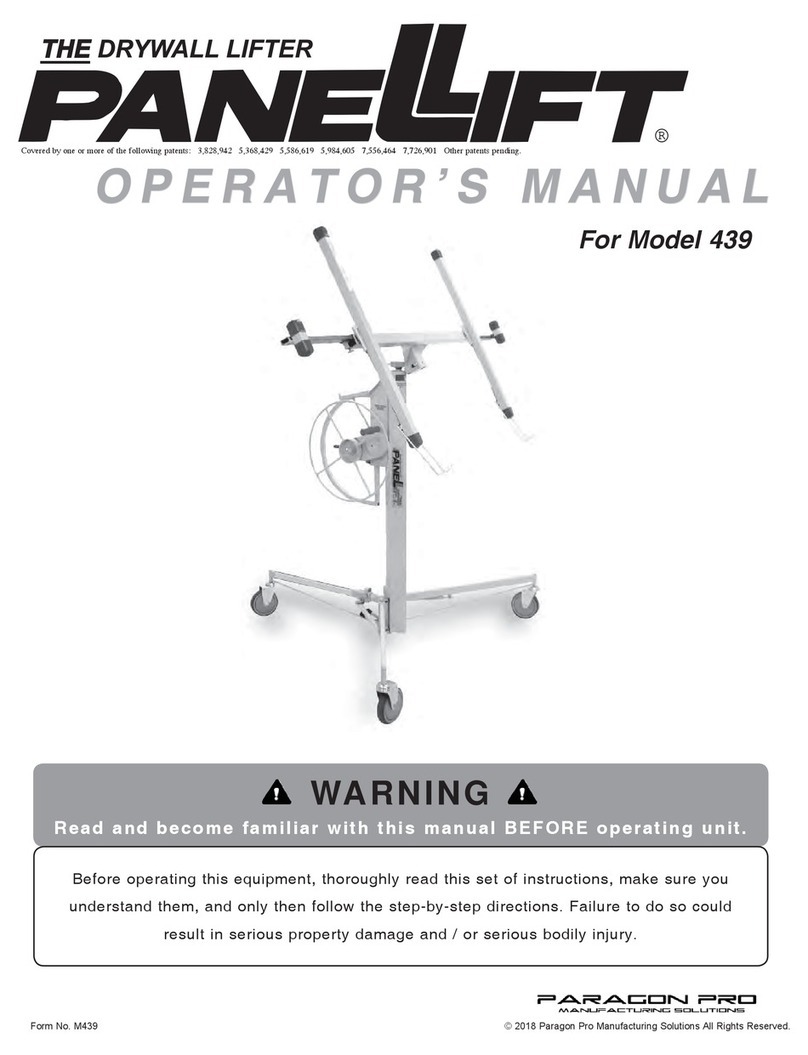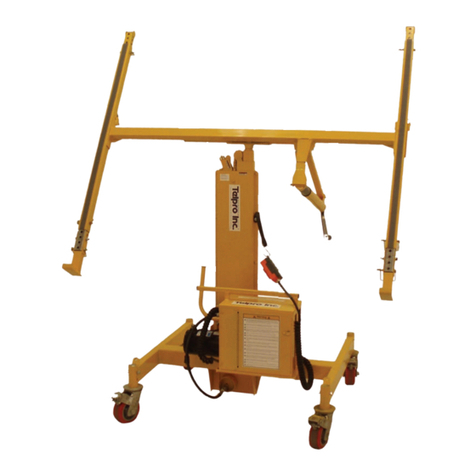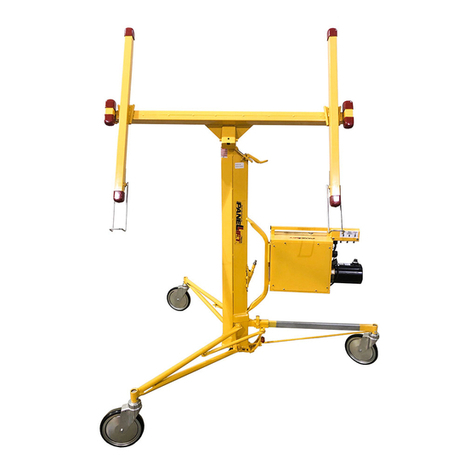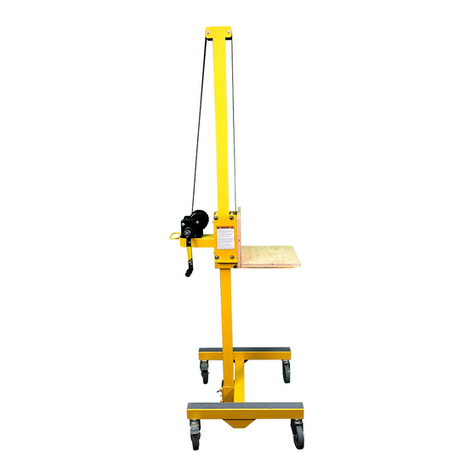
2
ASME Standards for wire rope (cable) inspection and replacement
Reprinted with permission from ASME B30.19 Cableways
The following is intended as a helpful guide to the general topic of inspection and replacement
of wire rope (cable). It is not intended to be an exhaustive treatment of the topic.
Frequent inspection (at least daily) by a competent person and prompt replacement of any cable that shows any sign of
wear is the responsibility of the owner and the operator of the PANELLIFT®Drywall Lift.
With reference to the chart below at 19-2.4.3(b)(6) the Panellift® Drywall Lift cable is a nominal 1/8” high tensile cable (rope).
(3) Care shall be taken when inspecting sectionsofrapid deterioration,
such as the following:
(a)sections in contactwith saddles,equalizersheaves, or othersheaves,
including track cable sheaves, where rope travel is limited;
(b) sections of the rope at or near terminal endswhere corroded or broken
wiresmaydevelop.
19-2.4.3 Rope Replacement
(a) No precise rules can be given for determination of the exact time for
rope replacement, since many variable factorsare involved. Once a rope
reachesanyone of the specified removal criteria,itmaybe allowed to
operate to the end of the work shift, based on the judgment of a qualified
person. The rope shall be replaced after thatwork shift, at the end of the day,
or at the latest time prior to the equipmentbeing used by the next work shift.
(b) Removal criteria for rope replacement shall be as follows:
(1) In running ropes, six randomlydistributed broken wiresin one lay,
or three broken wiresin one strand in one lay.
(2) One outer wire,broken at the contact pointwith the core of the rope,
thathasworked its wayout of the rope structure and protrudesand loopsout
from the rope structure. Additional inspection of this section is required.
(3) Wear of one-third the original diameter of outside individual wires.
(4) Kinking, crushing,birdcaging,or any other damage resulting in
distortion of the rope structure.
(5)Evidence of heatdamage fromanycause.
(6) Reductions from nominal diameter greater than those shown below:
(7) In standing ropes, more than two broken wires in one lay in sections
beyond end connections, or more than one broken wire at an end connection.
(c) Brokenwireremovalcriteriacited in this Volumeapply to wirerope
operating on steel sheaves and drums. The user shall contact the sheave,
drum,or cablewaymanufacturer, or aqualified person for broken wire
removal criteria for wire ropesoperating on sheaves and drumsmade of
material other than steel.
(d) Replacementrope shall haveanominal strength rating at leastequal
to the original rope furnished or recommended by the cablewaymanufacturer
or designer, or a qualifiedperson. Any deviation from the originalsize,grade,
or construction shall be specified by the rope manufacturer, the cableway
manufacturer or designer, or aqualified person.
(e) RopesNotin Regular Use. All rope thathasbeen idle for aperiod
of a month or more due to shutdown or storage of a cablewayon which
it is installed shall be given an inspection in accordance with para.19-
2.4.2(b) before it is placed in service. Thisinspection shall be for all types of
deteriorationandshall be performed by an appointed or authorizedperson.
(f) Inspection Records
(1) Frequentinspection-no recordsrequired.
(2) Periodicinspection -in order to establish data as a basis for judging
the proper time for replacement, adated reportofrope condition at each
periodicinspection shall be kepton file. Thisreport shall cover points of
deterioration listed in para.19-2.4.2(b)(2).
(g) A long-range inspection program should be established and should include
records on examination of rope removed from service so a relationship can
be established between visual observation and actual condition of the internal
structure.
(00) General
…The use of cableways, cranes, derricks, hoists, hooks, jacks, and slings
is subject to certainhazards thatcannot be met by mechanicalmeansbut
only by the exercise of intelligence, care,and common sense. It is therefore
essential to have personnel involved in the use and operation of equipment
who are competent, careful,physicallyand mentallyqualified,and trained in
the safe operation of the equipmentand the handling of the loads. Serious
hazardsareoverloading,dropping or slipping of the loadcaused by improper
hitching or slinging,obstructing the free passage of the load,and using
equipment for apurpose for which it wasnotintended or designed.
…
Section 19-2.4: Rope Inspection,Replacement, and Maintenance
19-2.4.1 General. Sheave diameters, drum diameters, and rope design
factorsare limited because of cablewaydesign configuration.Due to
these parameters, inspection in accordance with para.19-2.4.2 to detect
deterioration and timely replacementin accordance with para.19-2.4.3 are
essential.
19-2.4.2 Inspection
(a) Frequent Inspection
(1) All running ropes in service should be visually inspected once each
working day. A visual inspection shall consist of observation of all rope that
can reasonablybe expected to be in use during the day’s operations. These
visual observations should be concerned with discovering gross damage that
may be an immediate hazard,such as listed below:
(a) distortion of the rope such as kinking, crushing,unstranding,birdcaging,
main stranddisplacement, or coreprotrusion.Loss of ropediameter in a short
rope length or unevenness of outer strands should provide evidence that the
rope or ropesare to be replaced.
(b) general corrosion;
(c) broken or cut strands;
(d) number, distribution,and type of visible broken wires[see paras. 19-
2.4.3(b)(1),(2),and (7) for further guidance];
(e) core failure in rotation-resistantropes;when damage is suspected, the
rope shall either be removed from service or given an inspection as detailed
in para.19-2.4.2(b).
(2) Care shall be taken when inspecting sectionsofrapid deterioration,
such as flange points, crossover points, and repetitive pickup points on
drums.
(3) Care shall be taken when inspecting certain ropes, such as
rotation-resistantropes,because of their higher susceptibility to damage
and increased deterioration when working on equipmentwith limited design
parameters. The internal deterioration of rotation-resistantropesmaynot be
readilyobservable.
(b) Periodic Inspection
(1) The inspection frequency shall be determined by a qualified person
and shall be based on such factors as expected rope life (determined by
experience on the particular installation or similar installations), severity of
environment, percentage of capacity lifts, frequency rates of operation,and
exposure to shockloads. Inspections need notbe at equal calendar intervals
and should be more frequent as the rope approaches the end of its useful life.
The inspection shall be made at least every1000 hr of cablewayoperation or
annually, whichever comes first.
(2) Periodicinspections shall be performed by an appointed or
authorizedperson. Thisinspectionshallcover the entirelength of rope. Only
the surface wires of the rope need be inspected.No attempt should be made
to open the rope. Any deterioration resulting in appreciable loss of original
strength, such as described below, shall be noted,and adetermination shall
be made as to whether furtheruse of the ropewouldconstitute a hazard:
(a) points listed in para.19-2.4.2(a):
(b) reduction of rope diameter below nominal diameter due to loss of core
support, corrosion,or wear of outside wires;
(c) severely corroded or broken wiresatend connections;
(d) severely corroded, cracked, bent, worn, or improperly applied end
connections.
Max. Allowable
Reduction From
Rope Diam. Nominal Diam.
Up to 5/16 in. (8 mm) 1/64 in. (0.4 mm)
Over 3/8 in. up to 1/2 in. (13 mm) 1/32 in. (0.8 mm)
Over 9/16 in. up to 3/4 in. (19 mm) 3/64 in. (1.2 mm)
Over 7/8 in. up to 1 1/8 in. (29 mm) 1/16 in. (1.6 mm)
Over 1 1/4 in. up to 1 1/2’ in. (38 mm) 3/32 in. (2.4 mm)
